
Wine Culture and Information since 2002 - Volume 22
 Wine Culture and Information since 2002 - Volume 22 |
|
Issue 108, June 2012 |
Contents |
|
|
Underselling Wines |
|
We are facing a crisis. This is not anything new, this is something we are hearing for a long time and every day. Economy is not certainly having its best time, people is not having the best time ever, facing a limited personal financial possibility which can barely ensure a decent life style. In this context, which does not seem to give signs or reprise, people are forced - this is understandable - to set essential priorities while leaving little or no possibility to everything that, in this moment, has an elitist meaning or however not indispensable. Wine, it is very likely, belongs to this category, and it is having a little or lesser chance to get to the table of Italian because of the diminished availability of money. The consequence of this also affects both the profits and the activity of wine producers, forced to think about new commercial strategies in order to ensure themselves, as hard as they can, the indispensable profit. The effect of crisis can also be seen in the shelves of shops. The prices of many wines have in fact underwent a substantial fall, also those wines which have always had a historical and strong fame and were sold at certain prices. Wines that, not so long ago, were sold at an average price of 20-30 euros, today - in certain cases and for some producers - it is not uncommon to see the same wines undersold at few euros, sometimes even less than 5 euros. If it is true a news like that would make many consumers very happy and, last but not the least, their wallets as well, it is also true this is the clear sign of the difficulties producers are having in selling their wines. Price does not make quality, or better to say, it does not always make it, although sometimes it clearly increases the possibility. The equation “an expensive wine is equal to a good wine”, is not that reliable, as - glass on hand - it frequently happens a wine sold at a modest price is better, as a matter of fact, than many other expensive bottles. Wines sold at less than 5 euros are not anything new, as this commercial strategy has been widely used for wines of modest quality, also for certain DOC (Denominazione d'Origine Controllata, Denomination of Controlled Origin) and DOCG (Denominazione d'Origine Controllata e Garantita, Denomination of Controlled and Guaranteed Origin) wines. If this commercial strategy was mainly used in the past for wines of certain areas - some of them also being famous and not only in Italy - today it seems to be used to a higher and increasing number of wines from other and renowned areas. One could say there is the freedom, for the producer, to choose the price for his or her wines, therefore in case he or she makes the decision to undersell them, it is just a matter of choice. However, seeing a wine one month ago was sold at 20 euros and today it is sold at less than 5 euros, this can be cause of legitimate doubts. Is it a speculation done one month ago, or a “promotional gift” a producer wants to give clients, both to keep the old ones while getting new ones? Or, are they simply unsold wines, now undersold, in order to avoid the risk of not selling those wines at all? In any case, the sign is clear: the wine, that wine, is too expensive and at a price higher than few euros remains unsold. If we do a quick calculation, by considering the profits to be ensured to all the commercial subjects involved to the distribution of each bottle, the real costs for making and bottling a wine can hardly justify that price. In fact, in case we consider the wine - even a bad quality wine however has production costs - the bottle, label, cork and cap, as well as packaging and shipment, it is easy to understand production and distribution costs are higher than the few euros at which each bottle is being sold. Commercial strategies of large distribution chains, which sometimes decide to sell a product at “below cost” in order to recover - indeed, to increase - the loss of profit by selling other products, does not always justify these choices. If the lowering of prices of wines is welcomed by consumers with evident satisfaction, some consortiums for the safeguarding of Denominazioni d'Origine Controllata consider this phenomenon as dangerous both for the prestige of the denomination itself, as well as for the loss of profits. In some cases they even suggested the introduction of a minimum price for each bottle, a price no producer is allowed to lower, in other words, a minimum fixed retail price. It can be understood the safeguarding of a legitimate profit to anyone running a business - and a winery is no exception - however there is also the risk this message can be negatively perceived by consumers. Setting a minimum fixed retail price, looks like a political choice instead of something decided for economic reasons. In other words, it is the arrogant and presumptuous will to claim the wines of certain areas - as such - must be however “expensive”. Indeed, the ruthless evaluation of facts shows not all the wines belonging to a certain area, even renowned and famous, are worth the price at which they are sold. In medio stat virtus (the vitrue is in the middle), taught us our ancestors. It certainly makes everyone think to see a wine sold at an improbable price and not plausible in “industrial” terms, however it also makes everyone think to see a wine sold at a very high price. In both cases, it is legitimate to ask “where is the trick” or, maybe, the cheat. Price is not always associated to the real quality of a wine. If it is true a high price should - or better, could - ensures a product of better quality, a very low price can be easily associated to a product of mediocre quality or bad. In case a bottle is being sold, for example, at 2.50 euros - a price frequently corresponding to reality - what is the real production cost for the wine alone? Few tens of cents per liter and, it should be said, there are many producers capable of ensuring this price to any possible “bottler” who can ensure the purchase of a remarkable quantity. How that wine is really made is sometimes an enological mystery. A non adulterated wine - hopefully - however produced with disputable quality criteria or however nonexistent. Underselling quality: this too is a sign of crisis. Antonello Biancalana
|
||||
Sugar in TastingIn wine, when you think about sugar, you usually think about the organoleptic sensation of sweetness, indeed it is a very useful element for gustatory balance |
|
Without sugar, or better to say, sugars, wine could not exist. Not only essential elements for the production of one of the typical characteristics of wine - alcohol - but also, and in particular, an element for reaching a balance in the beverage of Bacchus. Let's clear this: wine does not mean alcohol and, of course, wine is more than a simple alcoholic beverage. Sugar - more precisely, the quantity found in the must and then in the wine - is fundamental both for the organoleptic characteristics of wine as well as for its balance. The presence or absence of sugar in wine determines its style and the organoleptic orientation. If it is true a substantial quantity of sugar classifies the wine as sweet and the absence - or a negligible quantity - classifies it as dry, in between quantities create very particular sensorial profiles. On this regard, we could think - for example - about sparkling wines and the many sensorial differences created by the quantity of sugar found in a wine. Sugar, in fact, is not found in “sweet” wines only, or at least, only in those wines in which the organoleptic sensation of sweetness is dominant or clearly perceivable. The perception of sweetness, just like any other gustatory sensation, is purely relative and in function of the intensity of antagonist or synergic stimuli. The lack of perception of a sensation does not in fact mean the absence of the substance producing it, it could also mean an organoleptic condition in which that specific substance is efficiently contrasted - or balanced - by other substances. We can think, for example, about certain wines produced with late harvested grapes and which could contain a certain quantity of residual sugar - that is non fermented sugars therefore capable of producing the sensation of sweetness - nevertheless, the taste of these wines can also be defined as dry. The appreciation of sweetness in wines - it should be said - has greatly changed in the course of wine making history and in the evolution of taste in relation to the beverage of Bacchus. If in past times, at the times of ancient Greeks, at the beginning of enology, sweet wines were the most precious and appreciated ones, today modern taste is mainly oriented towards dry wines. The present production of sweet wines is in fact marginal in regard to dry and table wines, caused by a lower demand and, therefore, a lesser interest of consumers. To this should necessarily be added the economic factor, as the production of a high quality sweet wine, produced with dried grapes, has very high costs, therefore, a very high retail price. In past times, also after the introduction of the practice of making dry wines, sweet wines - produced with dried grapes and, most of the times, affected by noble rot - were considered the highest expression of the god Bacchus and, just like today, they were very expensive wines, destined to the glasses of noble and rich people only.
Sugar is essential for the production of wine; as a simple matter of fact, without sugar, there would not exist wine nor any other fermented beverage. This is not something associated to the primary product of fermentation only - alcohol - but also, and in particular, to the remarkable chemical transformations to which grape sugar undergoes during the journey which will transform it into wine. The main responsible agent of alcoholic fermentation - Saccharomyces Cerevisiae - thanks to the conversion of the sugar found in grape juice, produces alcohol and carbon dioxide. Without sugar, therefore, wine would not exist, and not even beer and bread, as to mention the most famous examples of products obtained by the fermentation done by yeast. Not all the sugars are the same and not all the sugars can be fermented by the same type of yeast: each type of yeast - as a matter of fact - can convert specific types of sugar only. Before discussing the role of sweetness in wine sensorial tasting, let's try to understand the origin of sugars found in grape juice and used in enology. In nature, sugars - better defined as glucides - are essential elements to ensure the survival of most of living beings. The search of glucides is one of the main activities of living organisms, as they are useful nutrients for the supplies of energy. Plants, and in particular their fruits, are generally rich in sugar and make of them among the most common and looked for foods for most of beings belonging to the animal species. Grape, of course, is no exception, as inside of its small berries, when they reach full ripeness, can be found a remarkable quantity of sugar. It must be said, this is not the common sugar, as with this term is usually referred the so called table sugar, properly defined sucrose. In the berries of grape are found many types of sugar, however the main ones, also representing the highest quantity, are glucose and fructose. Not all the sugars found in grape's pulp are involved in the process of alcoholic fermentation. Some of them - called unfermentable sugars - are not in fact converted into alcohol and carbon dioxide, therefore leaving to the wine a certain “sweetness”. This sweetness, produced by the so called residual sugars, is not always perceivable to the tasting, both because they are balanced by other substances, as well as because they are found in negligible quantity and such not to reach the level of the threshold of perception. In some cases, the fermentation process is stopped on purpose, therefore not allowing the yeast to complete its job, leaving part of the fermentable sugar to the wine that, also in this case, will make the fraction of residual sugars and the organoleptic sensation of sweetness. The presence of sugar in wine can be obtained in other ways as well. One of them consists in adding to the wine - therefore to the product obtained at the end of fermentation - a certain quantity of sugar in order to increase sweetness. It should be said this practice, as a matter of fact, is forbidden by the laws of most of wine making countries in the world and the only wines in which this is permitted are sparkling wines. The more or less evident sweetness in sparkling wines produced with the classic method is in fact obtained in this way, by adding to the wine refermented in bottle, a mixture of wine, sugar and, in some cases and according to the style of the producer, aged wine brandy. The quantity of sugar added to sparkling wines - that in other wine styles would be enough to cause a well perceptible sweetness sensation - is not always enough to make its perception evident. In this particular wine style, carbon dioxide in fact plays an efficient role of contrast against sugar, by lowering the relative perception of sweetness. There is also another way to obtain the presence of sugar in wine, a method which can be considered natural. Fermentation, as already said, converts sugar into alcohol and carbon dioxide thanks to the job done by yeast. Alcohol is however a toxic substance and, although it is produced by yeast, its tolerance for this element is however limited. When in the must is present a high quantity of sugar - such as in case of must produced with overripe or dried grapes - yeast finds abundant “food” while continuing the production of alcohol that will end up intoxicating it and, therefore, this will stop the fermentation process. The interruption of fermentation therefore leaves to the wine a certain quantity of natural sugar which will give sweetness to the wine. On this regard it should be noticed every type of yeast has its own tolerance towards alcohol and some of them can also stand to exceptional quantities as high as 20% of total volume. In general terms, an alcohol by volume higher than 17% is usually toxic for most of yeast types. The contribution of sugar to wine sensorial tasting goes beyond the simply sensation of sweetness. By just considering it for the perception of what it probably is the most appreciated “taste” for human beings, it would simply be an error of unforgivable superficiality. Sugar mainly contributes with the taste of sweetness - there is no doubt about this - however its role in the overall profile in wine's taste is remarkably complex. Sugar - and more precisely, sweetness - plays a fundamental role in the balance of many elements, on the other hand, it needs to be properly balanced in order not to be excessive. The right sweetness, in the sense of balanced, in fact gives the wine a rare “noble” and “aristocratic” dimension, whereas its unbalance because of the excess, make the wines completely ungraceful, flat as well as cloying. Among the substances found in wine, sugar creates a particular relation of balance with acid substances. Acidity is in fact the primary organoleptic quality capable of effectively balancing sweetness. For the sake of comprehensiveness, the action of balance done by a substance towards another, it is never referred to the alteration of the quantity of each element found in wine. Balance is the action of sensorial contrast having as an effect, not the diminishing of the quantity of a certain substance, but the alteration of its perception, therefore making the sensation balanced and harmonious according to the other ones. A good example is offered by lemon juice. This substance, with an acidic and sour taste, has an excellent gustatory balance with the adding of a substance of sweet taste. By adding sugar, the quantity of acid substances does not diminish, however the gustatory sensation is made more tolerable, that is balanced, by sweetness. If it is true sweetness is capable of making acidity more tolerable, acidity has the property of making sweetness more pleasing and less cloying. For this reason, the most important quality in sweet wines is not necessarily represented by the quantity of sugar, indeed by the quantity of acid substances capable of properly balancing sweetness, therefore avoiding the wine to become cloying. Also carbon dioxide plays an effective role of contrast towards sweetness. In general terms, the action of carbon dioxide lowers - even significantly - the perception of sugar, and the wine, or any other beverage, will be perceived less sweet than it really is. We should think, for example, to a soda drink: when the effervescence is clearly perceptible, sweetness is less intense; by allowing carbon dioxide to get dispersed, because of the effect of shaking, sweetness will be more intense, even cloying. The same principle is applied, of course, to sparkling wines: despite they frequently contain an appreciable quantity of sugar, because of the effect of carbon dioxide, they could also be perceived as dry to the taste. Among the substances found in wine, in particular in red wines, sugar tends to make more tolerable the astringency of tannins, however the combination tannins-sugar, in case it is not properly controlled, can sometimes be unpleasant to the taste. Temperature is among the factors altering the perception of sweetness. The perception of sweet substances will be more intense as the temperature increases, whereas extremely low temperatures can also eliminate their perception. A sweet wine served cool will therefore be less sweet, whereas it can also become cloying in case it is served at a high temperature, even in case of a wine having a small quantity of residual sugar. Finally, among the substances found in wine, it should be noticed ethyl alcohol - besides producing the characteristic tactile burning sensation - has also a basically sweet taste which contributes to the overall sweetness of wine.
|
||||||||||||
Wines of the Month |
|
|
|
Score legend Prices are to be considered as indicative. Prices may vary according to the country or the shop where wines are bought |
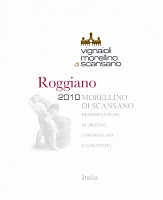
|
|
Morellino di Scansano Roggiano 2010 |
|
| Vignaioli del Morellino di Scansano (Tuscany, Italy) | |
| Grapes: Sangiovese | |
| Price: € 7.00 | Score: |
| Morellino di Scansano Roggiano shows a brilliant ruby red color and nuances of ruby red, moderate transparency. The nose denotes intense, clean and pleasing aromas which start with hints of black cherry, blueberry and violet followed by aromas of raspberry, plum and blackberry. The mouth has good correspondence to the nose, a properly tannic attack and however balanced by alcohol, good body, intense flavors. The finish is persistent with flavors of black cherry, blueberry and plum. Morellino di Scansano Roggiano ages in steel tanks. | |
| Food Match: Stuffed pasta, Sauteed meat, Stewed meat | |
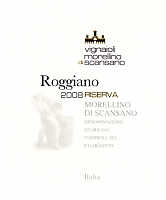
|
|
Morellino di Scansano Riserva Roggiano 2008 |
|
| Vignaioli del Morellino di Scansano (Tuscany, Italy) | |
| Grapes: Sangiovese (90%), Merlot (10%) | |
| Price: € 14.00 | Score: |
| Morellino di Scansano Riserva Roggiano shows an intense ruby red color and nuances of ruby red, moderate transparency. The nose denotes intense, clean, pleasing and refined aromas which start with hints of black cherry, plum and violet followed by aromas of blueberry, vanilla, tobacco and mace. The mouth has good correspondence to the nose, a properly tannic attack and however balanced by alcohol, good body, intense flavors, agreeable. The finish is persistent with flavors of black cherry, plum and blueberry. Morellino di Scansano Riserva Roggiano ages in barrique for 12 months followed by 10 months of aging in bottle. | |
| Food Match: Stewed meat with mushrooms, Broiled meat and barbecue, Stuffed pasta | |
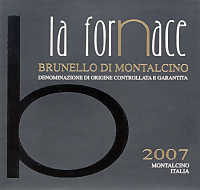
|
|
Brunello di Montalcino 2007 |
|
| La Fornace (Tuscany, Italy) | |
| Grapes: Sangiovese | |
| Price: € 28.00 | Score: |
| This Brunello di Montalcino shows a brilliant ruby red color and nuances of garnet red, moderate transparency. The nose reveals intense, clean, pleasing and refined aromas which start with hints of black cherry, plum and violet followed by aromas of blueberry, blackberry, vanilla, tobacco, chocolate, mace and menthol. The mouth has good correspondence to the nose, a tannic attack and however balanced by alcohol, full body, intense flavors, agreeable. The finish is persistent with flavors of black cherry, plum and blueberry. This Brunello di Montalcino ages for 36 months in cask and barrique. | |
| Food Match: Game, Roasted meat, Stewed and braised meat, Hard cheese | |
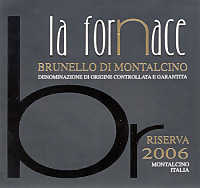
|
|
Brunello di Montalcino Riserva 2006 |
|
| La Fornace (Tuscany, Italy) | |
| Grapes: Sangiovese | |
| Price: € 48.50 | Score: |
| This Brunello di Montalcino Riserva shows an intense ruby red color and nuances of garnet red, moderate transparency. The nose denotes intense, clean, pleasing, refined and elegant aromas which start with hints of black cherry, plum and violet followed by aromas of blueberry, blackberry, vanilla, raspberry, chocolate, cinnamon, mace, tobacco and menthol. The mouth has good correspondence to the nose, a tannic attack and however balanced by alcohol, full body, intense flavors, agreeable. The finish is persistent with flavors of black cherry, plum and blackberry. This Brunello di Montalcino Riserva ages in barrique for 48 months followed by 6 months of aging in bottle. | |
| Food Match: Game, Roasted meat, Braised and stewed meat, Hard cheese | |
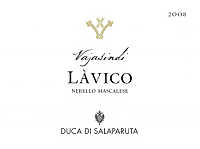
|
|
Vajasindi Lavico 2008 |
|
| Duca di Salaparuta (Sicily, Italy) | |
| Grapes: Nerello Mascalese | |
| Price: € 9.90 | Score: |
| Vajasindi Lavico shows a brilliant ruby red color and nuances of garnet red, moderate transparency. The nose reveals intense, clean, pleasing and refined aromas which start with hints of cherry, plum and raspberry followed by aromas of blueberry, strawberry, rose, vanilla, tamarind, carob and menthol. The mouth has good correspondence to the nose, a properly tannic attack and however balanced by alcohol, good body, intense flavors, agreeable. The finish is persistent with flavors of cherry, plum and raspberry. Vajasindi Lavico ages for 12 months in barrique. | |
| Food Match: Stuffed pasta with mushrooms, Stewed meat with mushrooms | |
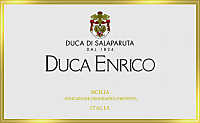
|
|
Duca Enrico 2007 |
|
| Duca di Salaparuta (Sicily, Italy) | |
| Grapes: Nero d'Avola | |
| Price: € 36.00 | Score: |
| Duca Enrico shows an intense ruby red color and nuances of garnet red, little transparency. The nose reveals intense, clean, pleasing, refined and elegant aromas which start with hints of blackberry, plum and black cherry followed by aromas of dried violet, blueberry, raspberry, vanilla, tobacco, chocolate, pink pepper, mace and menthol. The mouth has excellent correspondence to the nose, a tannic attack and however balanced by alcohol, full body, intense flavors, pleasing roundness. The finish is very persistent with long flavors of blackberry, plum and black cherry. Duca Enrico ages for 18 months in cask followed by 18 months of aging in bottle. | |
| Food Match: Game, Roasted meat, Braised and stewed meat, Hard cheese | |

|
|
Falerio Avora 2010 |
|
| Vigneti Vallorani (Marches, Italy) | |
| Grapes: Passerina, Pecorino, Trebbiano Toscano | |
| Price: € 13.00 | Score: |
| Falerio Avora shows a pale straw yellow color and nuances of greenish yellow, very transparent. The nose denotes intense, clean and pleasing aromas which start with hints of apple, plum and hawthorn followed by aromas of pear, citrus fruits and broom. The mouth has good correspondence to the nose, a crisp attack and however balanced by alcohol, good body, intense flavors. The finish is persistent with flavors of apple, plum and pear. Falerio Avora ages for 10 months in steel tanks. | |
| Food Match: Fried fish, Pasta with fish and crustaceans, Sauteed fish | |

|
|
Rosso Piceno Polisia 2010 |
|
| Vigneti Vallorani (Marches, Italy) | |
| Grapes: Sangiovese, Montepulciano | |
| Price: € 15.00 | Score: |
| Rosso Piceno Polisia shows a brilliant ruby red color and nuances of ruby red, moderate transparency. The nose denotes intense, clean, pleasing and refined aromas that start with hints of plum, black cherry and blueberry followed by aromas of raspberry, violet, cyclamen and blackberry. The mouth has good correspondence to the nose, a tannic attack and however balanced by alcohol, good body, intense flavors, agreeable. The finish is persistent with flavors of black cherry, plum and blueberry. Rosso Piceno Polisia ages for 10 months in steel tanks. | |
| Food Match: Pasta with meat and mushrooms, Stewed meat with mushrooms, Broiled meat and barbecue | |
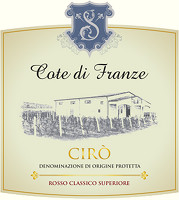
|
|
Cirò Rosso Classico Superiore 2010 |
|
| Cote di Franze (Calabria, Italy) | |
| Grapes: Gaglioppo | |
| Price: € 13.00 | Score: |
| This Cirò Rosso Classico Superiore shows a brilliant ruby red color and nuances of garnet red, moderate transparency. The nose denotes intense, clean and pleasing aromas which start with hints of plum, black cherry and dried violet followed by aromas of blueberry, blackberry, graphite and black pepper. The mouth has good correspondence to the nose, a properly tannic attack and however balanced by alcohol, good body, intense flavors. The finish is persistent with flavors of plum, black cherry and blackberry. This Cirò Rosso Classico Superiore ages for 12 months in steel tanks. | |
| Food Match: Pasta with meat, Stewed meat with mushrooms, Broiled meat and barbecue | |
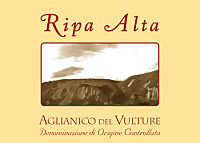
|
|
Aglianico del Vulture Ripa Bianca 2008 |
|
| Mario Pascale (Basilicata, Italy) | |
| Grapes: Aglianico | |
| Price: € 10.00 | Score: |
| Aglianico del Vulture Ripa Bianca shows an intense ruby red color and nuances of ruby red, little transparency. The nose denotes intense, clean, pleasing and refined aromas which start with hints of black cherry, plum and blackberry followed by aromas of violet, blueberry, raspberry and carob. The mouth has good correspondence to the nose, a properly tannic attack and however balanced by alcohol, good body, intense flavors, agreeable. The finish is persistent with flavors of black cherry, plum and blackberry. Aglianico del Vulture Ripa Bianca ages for 10 months in steel tanks followed by 6 months of aging in bottle. | |
| Food Match: Pasta with meat and mushrooms, Broiled meat and barbecue, Stewed meat with mushrooms | |
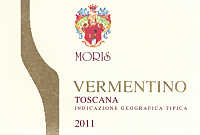
|
|
Vermentino 2011 |
|
| Moris Farms (Tuscany, Italy) | |
| Grapes: Vermentino (90%), Viognier (10%) | |
| Price: € 8.90 | Score: |
| This Vermentino shows a brilliant greenish yellow color and nuances of greenish yellow, very transparent. The nose reveals intense, clean, pleasing and refined aromas which start with hints of peach, apple and plum followed by aromas of pineapple, pear, hawthorn, chamomile and almond. The mouth has good correspondence to the nose, a crisp attack and however balanced by alcohol, good body, intense flavors, agreeable. The finish is persistent with flavors of peach, apple and plum. This Vermentino ages in steel tanks. | |
| Food Match: Fried fish, Fish and crustacean appetizers, Sauteed fish, Pasta with fish | |

|
|
Scalabreto 2009 |
|
| Moris Farms (Tuscany, Italy) | |
| Grapes: Montepulciano | |
| Price: € 16.90 - 50cl | Score: |
| Scalabreto shows a brilliant ruby red color and nuances of garnet red, moderate transparency. The nose reveals intense, clean, pleasing and refined aromas which start with hints of cherry, plum and dried violet followed by aromas of raspberry, blueberry, vanilla and blackberry. The mouth has good correspondence to the nose, a sweet and properly tannic attack, however balanced by alcohol, good body, intense flavors, agreeable. The finish is persistent with flavors of cherry, plum and raspberry. Scalabreto ferments and ages in barrique for 12 months. | |
| Food Match: Dried fruit tarts, Wild fruit tarts | |
News |
|
In this section are published news and information about events concerning the world of wine and food. Whoever is interested in publishing this kind of information can send us a mail to our address.
|
AquavitaeReview of Grappa, Distillates and Brandy |
|
|
| Distillates are rated according to DiWineTaste's evaluation method. Please see score legend in the "Wines of the Month" section. |
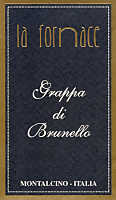
|
|
Grappa di Brunello |
|
| La Fornace (Tuscany, Italy) | |
| (Distiller: Distilleria Deta) | |
| Raw matter: Pomace of Sangiovese | |
| Price: € 20.00 - 500ml | Score: |
| This grappa is limpid, colorless and crystalline. The nose denotes intense, clean and pleasing aromas of black cherry, plum, violet, blackberry and hazelnut, with almost imperceptible alcohol pungency. In the mouth has intense flavors with perceptible alcohol pungency which tends to dissolve rapidly, good correspondence to the nose, pleasing roundness. The finish is persistent with flavors of plum, black cherry and hazelnut. Alcohol 43%. | |
Wine Parade |
|
|
| The best 15 wines according to DiWineTaste's readers. To express your best three wines send us an E-mail or fill in the form available at our WEB site. |
| Rank | Wine, Producer | |
|---|---|---|
| 1 |
| Batàr 2008, Querciabella (Italy) |
| 2 |
| Collio Sauvignon Ronco delle Mele 2010, Venica (Italy) |
| 3 |
| Brunello di Montalcino 2006, Siro Pacenti (Italy) |
| 4 |
| Barolo Cannubi Boschis 2005, Sandrone (Italy) |
| 5 |
| Gran Masetto 2007, Endrizzi (Italy) |
| 6 |
| Brunello di Montalcino Vigneto Manachiara 2005, Tenute Silvio Nardi (Italy) |
| 7 |
| Adarmando 2009, Tabarrini (Italy) |
| 8 |
| Rosso Conero Riserva Grosso Agontano 2007, Garofoli (Italy) |
| 9 |
| Franciacorta Pas Dosé Récemment Dégorgé 2006, Cavalleri (Italy) |
| 10 |
| Sagrantino di Montefalco Collepiano 2007, Arnaldo Caprai (Italy) |
| 11 |
| Arkezia Muffo di San Sisto 2004, Fazi Battaglia (Italy) |
| 12 |
| Avvoltore 2009, Moris Farms (Italy) |
| 13 |
| Confini 2007, Lis Neris (Italy) |
| 14 |
| Trento Talento Brut Riserva 2007, Letrari (Italy) |
| 15 |
| Trento Brut Riserva Methius 2004, Dorigati (Italy) |
| |||||||
Privacy Policy | |||||||


| Copyright © 2002-2024 Antonello Biancalana, DiWineTaste - All rights reserved |
| All rights reserved under international copyright conventions. No part of this publication and of this WEB site may be
reproduced or utilized in any form or by any means, electronic or mechanical, without permission in writing from DiWineTaste. |